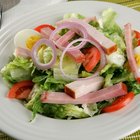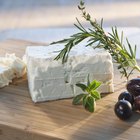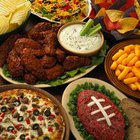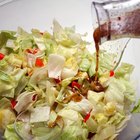
Salads are a good moneymaker for restaurants, as they generally require no cooking, little preparation, and inexpensive (yet tasty and healthy) ingredients which can be bought in bulk. The profit comes in the price, as the markup on salads is enormous. In order for a carryout restaurant to make profitable salads, the restaurant should focus on obtaining cheap quality ingredients, maintaining low overhead and adjusting prices to secure enough of a profit margin that they make money not only on the salads they sell but also on the ingredients they purchase.
Choose the ingredients that you want to buy. The focus should be on making delicious salads and, in addition, taking the cost of ingredients into account. For this reason, you may wish to avoid tuna (which can cost $2 per can) in favor of chicken or hard-boiled eggs for protein. Besides being a salad staple, lettuce is extremely cheap. Tomatoes, shredded carrots, cucumbers and apples are all relatively cheap and can be combined to make delicious salads.
Decide what types of salad dressing you want to serve. While it will be cheaper to make your own salad dressing, it can also be more time-consuming to make many salad dressings like blue cheese, ranch or Thousand Island. An oil and vinegar dressing will not take as long. However you obtain your dressings, pre-pack them in small, sealed plastic cups to save time when putting salads together.
Create a spreadsheet which has columns for the type of item, the unit in which it is sold (by the bag, piece or weight), the date on which the items were purchased, their cost (per sales unit or by weight) how many salads can be made with the item and include a column for the date on which the item was used. For example, if you buy one bag of lettuce on November 1, the bag weighs ten pounds, it cost $5 and you can make 20 salads with each bag, all of this information should be entered in the beginning. Then, if you use the whole bag by November 3, you will put that date in the final column. With this information you can track how much of each item you use, how much it costs per salad made, the profit (or loss) on each salad and how often you need to reorder particular ingredients.
When you have your raw ingredients, calculate how much of each you will use when making salads and how much that costs. For example, if you have the bag of lettuce which can make 20 salads and costs $5, you know that each salad will use 25 cents worth of lettuce. If you also use 50 cents worth of tomatoes, 5 cents worth of carrots, and 50 cents worth of other ingredients, your salad will cost $1.30. If you decide to sell it for $6.95, you will make $5.65 in profit for each salad. Use this information to set the prices of salads so that they are profitable. The USDA website can help you determine the proper wholesale prices for produce.
Related Articles

How to Eat Healthy for Less Than $10 a ...

Chef Salad Nutrition Information

How Many Calories Are in a Goat Cheese ...

How to Cater Your Own Party

Substitute for Italian Dressing

How to Make Cheap Wedding Tablecloths

How to Make Your Own Lean Cuisine

Menu Planning Objectives

Can Eating Salads & Fish Make You Lose ...

When Does Salami Spoil?

How to Store Homemade Salad Dressing

Can You Eat Expired Mayonnaise?

How to Feed a Large Family Healthy ...

Typical Markup of Retail Fashion

Calories in a Ham and Cheese Wrap

Low-Calorie Subway Food

Healthy Unprocessed Lunch Choices

Portillos / Barnellis Nutrition ...

How to Price the Worth of Household ...

How to Figure Costs for a Banquet
References
Tips
- Do research and find out what comparable salads in your area are selling for. This will help you know what you can sell salads for and also what your competition is selling.
Writer Bio
Andrew Samtoy started writing in 1997 in a college creative writing class and now contributes to "Tank Magazine," the Cleveland Sandwich Board and the London Review of Breakfasts. Mr. Samtoy graduated from Pitzer College with a Bachelor of Arts degree in literature and earned a Juris Doctorate at Case Western Reserve University. Mr. Samtoy is an attorney in Cleveland, Ohio.
Photo Credits
James And James/Brand X Pictures/Getty Images